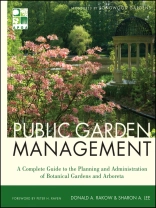The complete-and-ready reference for establishing, managing, and
running a successful and sustainable, profitable public garden
As unique museums with living collections of plants, public
gardens offer visitors aesthetically beautiful landscapes combined
with educational programming and scientific research that promote
the value and understanding of plants. In the twenty-first century,
public gardens are in the forefront of organizations and
institutions committed to promoting the conservation of plants and
their habitats, developing sustainable practices that support the
environment, and providing green spaces where our increasingly
stressed and urbanized citizens can reconnect with the natural
world. It is critically important that such institutions have
trained, knowledgeable staff members. Because of its comprehensive
examination of public gardens, Public Garden Management is
the ideal guide for staff members at public gardens, anyone
considering a career in public gardens, groups starting a botanical
garden or arboretum, and students discovering how these complex
institutions work.
Public Garden Management is an all-in-one professional
reference and textbook that clearly shows how to develop,
establish, manage, and maintain a sustainable–both
economically and environmentally–public garden. Offering
practical coverage of relevant topics, along with useful tools for
reinforcing study, this insightful and forward-thinking guide
is:
* Copublished by the American Public Gardens Association
* Written by a panel of leading experts in the field
* Filled with dozens of case studies that are real-world
illustrations of the principles explored in the text
* Illustrated throughout with line drawings, figures, and
photographs that assist in conveying critical information
Students and professionals will benefit greatly from the
management principles outlined in this book, helping them establish
and maintain new and existing public gardens that engage, inspire,
and connect with their communities.
Table des matières
Acknowledgments.
Foreword (Peter H. Raven).
Part I Public Gardens and Their Significance.
Chapter 1 What Is a Public Garden? (Donald A. Rakow).
Chapter 2 The History and Significance of Public Gardens
(Christine Flanagan).
Part II The Emerging Garden.
Chapter 3 Critical Issues in Starting a Public Garden (Robert
E. Lyons).
Chapter 4 The Process of Organizing a New Public Garden (Mary
Pat Matheson).
Chapter 5 Land Acquisition (Maureen Heffernan).
Chapter 6 Designing for Plants and People (Iain M.
Robertson).
Part III Administrative Functions.
Chapter 7 Staffing and Personnel Management (Gerard T.
Donnelly and Nancy L. Peske).
Chapter 8 Volunteer Recruitment and Management (Arlene
Ferris).
Chapter 9 Budgeting and Financial Planning (Richard
Piacentini and Lisa Macioce).
Chapter 10 Fund Raising and Membership Development (Patricia
Rich).
Chapter 11 Earned Income Opportunities (Richard H.
Daley).
Chapter 12 Facilities and Infrastructure (Eric
Tschanz).
Chapter 13 Grounds Management and Security (Vincent A.
Simeone).
Part IV Programmatic Functions.
Chapter 14 Public Gardens and Their Communities: The Value of
Outreach (Susan Lacerte).
Chapter 15 Formal Education for Students, Teachers, and Youth at
Public Gardens (Patsy Benveniste and Jennifer
Schwarz-Ballard).
Chapter 16 Continuing, Professional, and Higher Education
(Larry De Buhr).
Chapter 17 Interpreting Gardens to Visitors (Kitty
Connolly).
Chapter 18 Evaluation of Garden Programming and Planning
(Julie Warsowe).
Chapter 19 Public Relations and Marketing Communications
(Leeann Lavin and Elizabeth Randolph).
Chapter 20 Collections Management (David Michener).
Chapter 21 Research at Public Gardens (Kayri Havens).
Chapter 22 Conservation Practices at Public Gardens (Sarah
Reichard).
Part V Long-Term Initiatives.
Chapter 23 A Strategic Approach to Leadership and Management
(Kathleen Socolofsky and Mary Burke).
Chapter 24 Associations and Partnerships (Claire
Sawyers).
Chapter 25 Facility Expansion (Brian Holley).
Chapter 26 The Shape of Gardens to Come (Paul B.
Redman).
Appendix A: Factors in the Development and Management of
Canadian Public Gardens (Melanie Sifton and David
Galbraith).
Appendix B: The Importance of Plant Exploration Today (Paul
W. Meyer).
Appendix C: Herbaria (Barbara M. Thiers).
Appendix D: Public Garden Archives (Sheila Connor).
Appendix E: The Library in a Public Garden (Rita M.
Hassert).
Appendix F: Horticultural Therapy and Public Gardens (Karen
L. Kennedy).
References.
Contributors.
Index.
A propos de l’auteur
Donald A. Rakow, Ph D, serves as the Elizabeth Newman Wilds
Director of Cornell Plantations, as well as Director of the Cornell
Graduate Program in Public Garden Leadership. Actively involved in
horticultural associations and education initiatives at many
levels, Rakow is a frequent speaker at conferences and has been
honored with the APGA Service Award, for his service on American
Public Gardens Association’s board of directors and many of its
committees.
Sharon A. Lee is the principal of Sharon Lee &
Associates, a communications consulting firm, and is the former
deputy director of the American Public Gardens Association and the
founding editor of the Public Garden, the journal of the American
Public Gardens Association.












